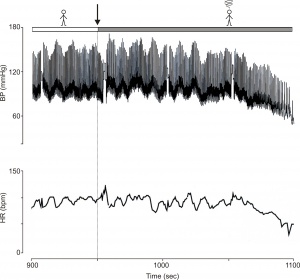A pilot with vasovagal syncope: fit to fly?
N. van Dijk, N. Colman, J.H.A. Dambrink, W. Wieling
Department of Medicine, Academic Medical Center, University of Amsterdam, Amsterdam (The Netherlands).
A 20 year old commercial pilot was referred for evaluation. He had fainted during a briefing for a training-session in the hypobaric room. During a subsequent medical examination by a neurologist and cardiologist the patient collapsed twice while talking about the first episode. During the faints he experienced lightheadedness, paleness and sweating. In his youth the patient had fainted once during a mass in church. Furthermore he avoided watching surgical procedures on television. Because of his faints the patient was grounded by the aeromedical service [1].
The patient was referred for further examination and advice. Physical examination and ECG were normal. Blood pressure in supine position was 130/70 mmHg and heart-rate 75 bpm. The patient showed a normal heart rate and blood pressure response upon active standing. After 5 minutes of standing the attending physician (WW) deliberately started talking about the first faint. Within 1 minute the patient got lightheaded, experienced a warm feeling, looked pale and was sweating. Heart rate dropped to 45 bpm and blood pressure from 160/85 mmHg to 80/45 mmHg. Lying down aborted ongoing vasovagal syncope (Fig. 1).
The patient recognized the symptoms. This confirmed the clinical diagnosis of emotionally induced vasovagal syncope. He was reassured regarding the nature of his problem and was advised to avoid provocative medical situations. While his episodes occurred only during predictable provocations and he experienced clear preceding symptoms, the chance of an episode occurring during flight was considered to be low. Therefore we recommended declaring the patient fit to fly. During a 5 year follow-up period, he has had no episodes of syncope and has been working as a commercial pilot.
Editor's comments
Vasovagal syncope is described as a benign condition, while the mortality of patients due to vasovagal spells is very low [1]. However, loss of consciousness in a critical situation like driving or flying could lead to serious accidents. According to the European criteria of the Joint Aviation Authorities (JAA), pilots with loss of consciousness can only be declared fit to fly when there is no chance of recurrence, the cause of syncope is clear and neurological examination shows no abnormalities[2].
According to the United States Federal Aviation Administration (FAA), a first syncopal episode makes a pilot unfit to fly. Only if there is a clear and avoidable medical explanation for the episode the pilot can be declared fit to fly[2]. This criterion may be applicable to pilots suffering from vasovagal syncope induced by medical situations[3].
Whether a pilot with vasovagal syncope can be declared fit to fly depends upon the possibility of recurrences during flight. To determine the risk, the vasovagal nature of the syncope must be absolutely certain[4]. Secondly the patient should have clear prodromi, to make sure precautions can be taken in case of symptoms. Awareness of provoking situations is crucial to allow precautions to be taken at an early stage [6]. The provoking factor should be avoidable during flight. A restriction to fly ‘as or with a co-pilot’ during a certain observational period may be considered as a first measure to resume flying[5].
References
- Kapoor WN. Evaluation and outcome of patients with syncope. Medicine (Baltimore). 1990 May;69(3):160-75. DOI:10.1097/00005792-199005000-00004 |
-
Department of transportation.Federal Aviation Administration. Guide for aviation medical examiners. 24-25, 28a. 61-62. 1999. Washington D.C., U.S.
-
Parts of this case were published earlier: van Dijk N, Colman N, Dambrink JH, Wieling W. Pilots with vasovagal syncope: fit to fly? Aviat Space Environ Med 2003; 74: 571-574. We thank Aerospace Medical Association for permitting this reproduction.
- Sutton R. Vasovagal syncope: prevalence and presentation. An algorithm of management in the aviation environment. Eur Heart J Suppl. 1999 Apr;1 Suppl D:D109-13.
- Joy M. Introduction and summary of principal conclusions of the Second European Workshop in Aviation Cardiology. Eur Heart J Suppl. 1999 Apr;1 Suppl D:D1-12.
-
Joint Aviation Authorities. JAR-FCL 3: flight crew licencing. 2000. Cheltenham, England, Printing and publication services.
